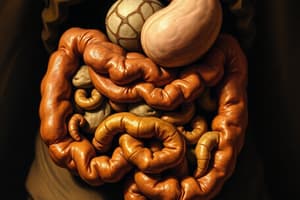Podcast
Questions and Answers
What is the primary function of the digestive system?
What is the primary function of the digestive system?
- To intake food, break it down, absorb nutrients, and excrete undigested food (correct)
- To produce hormones for metabolism
- To circulate blood throughout the body
- To regulate body temperature
Which process specifically describes the physical breakdown of food?
Which process specifically describes the physical breakdown of food?
- Chemical digestion
- Absorption
- Mechanical digestion (correct)
- Ingestion
What role do goblet cells play in the digestive system?
What role do goblet cells play in the digestive system?
- Transporting water in the bloodstream
- Producing digestive enzymes
- Absorbing nutrients from food
- Secreting protective mucus (correct)
What is the purpose of peristalsis in the digestive system?
What is the purpose of peristalsis in the digestive system?
What is a function of the small intestine's villi?
What is a function of the small intestine's villi?
Flashcards
Ingestion
Ingestion
The process of taking food into the mouth.
Digestion
Digestion
The breakdown of food into smaller molecules, both physically and chemically.
Absorption
Absorption
The movement of nutrients from the digestive system into the bloodstream.
Elimination
Elimination
Signup and view all the flashcards
Peristalsis
Peristalsis
Signup and view all the flashcards
Study Notes
Digestive System Overview
- The digestive system performs four main functions: ingestion, digestion, absorption, and elimination.
- Ingestion: Food enters the mouth.
- Digestion: Food is broken down mechanically (e.g., chewing) and chemically (e.g., by enzymes).
- Absorption: Nutrients are taken into the bloodstream.
- Elimination: Solid waste is removed from the body.
Ingestion and Mechanical Digestion
- Food enters the mouth.
- The tongue, teeth, and saliva break down food.
- Food moves to the esophagus.
- Mechanical digestion involves physically breaking down food, like chewing.
Chemical Digestion and Stomach
- Food is digested in the stomach (muscular contractions, hydrochloric acid).
- Chemical digestion breaks food molecules into smaller ones.
Small Intestine and Absorption
- Digestion continues in the small intestine.
- Nutrients are absorbed into the bloodstream.
- The small intestine has specialized structures (villi) to increase absorption surface area.
Large Intestine and Elimination
- Undigested food moves to the large intestine.
- Water and some nutrients are reabsorbed.
- Undigested material becomes feces.
- Feces are stored in the rectum and eliminated through the anus.
Peristalsis
- Peristalsis is a wave-like muscle movement that pushes food along the digestive tract.
- It moves in one direction.
- Reverse peristalsis occurs during vomiting.
Small Intestine Structure
- The small intestine is made up of multiple layers:
- Mucosa (epithelial tissue)
- Submucosa (connective tissue)
- Circular muscle fibers
- Longitudinal muscle fibers
- Serosa (connective tissue)
- Villi (epithelial tissue)
- Goblet cells secrete mucus to protect the lining.
Digestive System Function Summary
- The main function of the digestive system is to break down food, absorb nutrients, and dispose of waste.
Studying That Suits You
Use AI to generate personalized quizzes and flashcards to suit your learning preferences.




